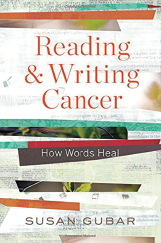
Bookmark
Title: Reading & Writing Cancer: How Words Heal
Author: Susan Gubar
Publisher: W. W. Norton & Company
Publication date: May 2016
Price: $26.95; hardcover, 240 pages
Feminist literary scholar Susan Gubar was diagnosed with advanced ovarian cancer in November 2008. She then began her emigration “from the world of the healthy to the domain of the ill,” she wrote in her acclaimed book, Memoir of a Debulked Woman: Enduring Ovarian Cancer. In her memoir, she details—with graphic honesty—the physical and emotional pain, the surgery, chemotherapy, “intestinal disasters,” and psychological changes that followed.
Ms. Gubar has recently added another book to her literary oeuvre, Reading & Writing Cancer: How Words Heal. According to Ms. Gubar, reading and writing about cancer alleviate some of the loneliness of the disease while enhancing a patient’s comprehension of how to grapple with it.
Ms. Gubar is an expert at being a cancer patient, and she notes in the foreword of her book that she has been kept alive for the past 2 years by a clinical trial out of the Indiana University Simon Cancer Center. And she also has benefited by the regular appearance of her blog in The New York Times, “Living With Cancer,” which she says “has been as life-enhancing for me as the packets of experimental drugs I receive.”
Central Theme
The central theme of Ms. Gubar’s book can be summarized by the following paragraph. “Because writing is sedentary, because it can be done anywhere, intermittently, by anyone, because it is cheap and need not involve a computer but can easily be accomplished with a pad and pencil, because it requires no other people, and because writing breeds writing, it remains one of the few activities available to many cancer patients.” She’s correct, even though she took a bit too long to make her point.
However well intentioned her advice, the author is a writer who travels in literary circles. To many, writing is a challenge, a task seen as work, not therapy, especially by patients with cancer, who are consumed with the day-to-day emotional and physical challenges of their disease. That said, in the opening section called, “Coming to Terms,” the author makes a solid case for taking pen to paper, for those patients so inclined. “But daily writing does more than provide an outlet for venting without self-censorship. Even when it tackles the miseries of treatment or the disease’s progression, it can also become an escape hatch.”
To her credit, Ms. Gubar gives handy tips for neophyte writers: how to begin a journal, suggestions of titles and authors to read for inspiration, and technical advice, bringing other noted authors to the discussion. At times it gets a bit highbrow, but the read is enriching and edifying.
A Walk on the Wild Side
Moving on to reading. In a chapter called “Impatient Memoirs,” the author takes a walk on the wild side and critiques, sometimes with a barbed pen, other cancer memoirs from well-known persons, delving into classics by Susan Sontag, Jay Gould, and famed comedienne Gilda Radner.
Daily writing does more than provide an outlet for venting without self-censorship. Even when it tackles the miseries of treatment or the disease’s progression, it can also become an escape hatch.— Susan Gubar
Tweet this quote
Of Ms. Radner’s battle to the end, the author writes: “The effort to be funny in the context of cancer seems audacious and at the same time wrenchingly doomed to failure. Gilda Radner takes on the poignant role of a sad clown, a Pagliacci or Chaplin.” Humor and laughter are defense mechanisms often used when we are faced with situations beyond our control. Here, Ms. Gubar should put analytics aside and open herself and the reader to the frailty of a young person facing her own mortality.
Fine Art
Following the writing and reading sections, Ms. Gubar enters the heady field of art and its palliative effect on cancer patients, who often may have the time and wherewithal to appreciate fine art. Unless the reader is familiar with the art world, this section will prove too challenging. That said, it is beautifully written, with poignant metaphors, and admirers of writers such as Atul Gawande will find this section particularly enjoyable.
Conversing With Readers
The most accessible section of the book is the final part titled “My Blog.” Here, the author steps down from the pulpit of high literature and has a conversation with the reader—She is candid and informative, as her opening sentence demonstrates. “The year before I was supposed to die, I wanted to address the problems of cancer and its treatments with a larger group of readers.”
Well, Ms. Gubar has not died, thanks to the cutting-edge—yet difficult—treatments she’s received in her long battle with cancer. During this time, she has gifted the community with brilliant, gutty insight into what it means to have cancer. Reading & Writing Cancer is recommended for the readers of The ASCO Post who enjoy erudite explorations into the world of cancer. ■

